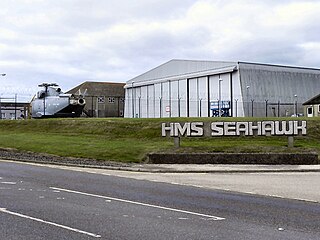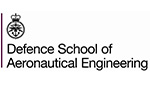
The Royal Air Force (RAF) is the United Kingdom's air and space force. It was formed towards the end of the First World War on 1 April 1918, becoming the first independent air force in the world, by merging the Royal Flying Corps (RFC) and the Royal Naval Air Service (RNAS). Following the Allied victory over the Central Powers in 1918, the RAF emerged as the largest air force in the world at the time. Since its formation, the RAF has played a significant role in British military history. In particular, during the Second World War, the RAF established air superiority over Hermann Göring's Luftwaffe during the Battle of Britain, and led the allied strategic bombing effort.

The Air Ministry was a department of the Government of the United Kingdom with the responsibility of managing the affairs of the Royal Air Force, that existed from 1918 to 1964. It was under the political authority of the Secretary of State for Air.

The Fleet Air Arm (FAA) is the naval aviation component of the United Kingdom's Royal Navy (RN). The FAA is one of five RN fighting arms. As of 2023 it is a predominantly "rotary" force, with helicopters undertaking roles once performed by biplanes such as the Fairey Swordfish. It operates the F-35 Lightning II for maritime strike and the AW159 Wildcat and AW101 Merlin for commando and anti-submarine warfare.

A flight engineer (FE), also sometimes called an air engineer, is the member of an aircraft's flight crew who monitors and operates its complex aircraft systems. In the early era of aviation, the position was sometimes referred to as the "air mechanic". Flight engineers can still be found on some larger fixed-wing airplanes and helicopters. A similar crew position exists on some spacecraft. In most modern aircraft, their complex systems are both monitored and adjusted by electronic microprocessors and computers, resulting in the elimination of the flight engineer's position.

Ministry of Defence Lyneham or MOD Lyneham is a Ministry of Defence site in Wiltshire, England, about 7 miles (11 km) north-east of Chippenham and 10 miles (16 km) south-west of Swindon. The site houses the Defence School of Electronic and Mechanical Engineering. Also here is Prince Philip Barracks, housing the regimental headquarters of the Royal Electrical and Mechanical Engineers (REME), 8 Training Battalion REME and the REME Museum.
Flight lieutenant is a junior commissioned rank in air forces that use the Royal Air Force (RAF) system of ranks, especially in Commonwealth countries. It has a NATO rank code of OF-2. Flight lieutenant is abbreviated as Flt Lt in the Indian Air Force (IAF) and RAF, and as FLTLT in the Pakistan Air Force (PAF), Royal Australian Air Force (RAAF) and Royal New Zealand Air Force (RNZAF) and has sometimes also been abbreviated as F/L in many services; it has never been correctly abbreviated as "lieutenant". A flight lieutenant ranks above flying officer and below a squadron leader and is sometimes used as an English language translation of a similar rank in non-English-speaking countries.
A group is a military unit or a military formation that is most often associated with military aviation.
Historically, an armourer is a person who makes personal armour, especially plate armour.

Royal Naval Air Station Culdrose is a Royal Navy airbase near Helston on the Lizard Peninsula of Cornwall UK, and is one of the largest helicopter bases in Europe. Its main role is serving the Fleet Air Arm's front line AgustaWestland Merlin helicopter squadrons.
The history of the Royal Air Force, the air force of the United Kingdom, spans a century of British military aviation.
The officer ranks of the Royal Air Force, as they are today, were introduced in 1919. Prior to that Army ranks were used.

A Weapon Systems Officer (WSO), nicknamed "Wizzo", is an air flight officer directly involved in all air operations and weapon systems of a military aircraft.

The Sri Lanka Air Force is the air arm and the youngest of the Sri Lanka Armed Forces. It was founded in 1951 as the Royal Ceylon Air Force (RCyAF) with the assistance of the Royal Air Force (RAF). The SLAF played a major role throughout the Sri Lankan Civil War. The SLAF operates more than 160 aircraft and has a projected trained strength of 30,000 airmen and 2000 officers, who are from both regular and reserve service.

The Defence School of Aeronautical Engineering(DSAE) is a Defence Training Establishment (DTEs) of the British Ministry of Defence. It was formed on 1 April 2004 and provides training for aircraft engineering officers and tradesmen across the three British armed forces. The school comprises a headquarters, No. 1 School of Technical Training and the Aerosystems Engineer and Management Training School all based at RAF Cosford, the Royal Naval Air Engineering and Survival Equipment School (RNAESS) at HMS Sultan, with elements also based at RAF Cranwell and MOD St. Athan.

No. 22 Group Royal Air Force is one of six groups currently active in the Royal Air Force (RAF), falling under the responsibility of Deputy Commander-in-Chief (Personnel) in Air Command. Its previous title up until 2018 was No. 22 (Training) Group. The group is responsible for RAF training policy and controlling the Royal Air Force College and the RAF's training stations. As such, it is the direct successor to Training Group. 22 Group provides training to all three service branches of the British Armed Forces; namely the Royal Air Force, the Royal Navy, and the British Army.

The Air and Space Warfare Centre (ASWC) is a Royal Air Force research and testing organisation based at RAF Waddington in Lincolnshire. It has a training branch nearby as a lodger unit of RAF Cranwell and other branches elsewhere, including at RAF High Wycombe, RAF Brize Norton, MoD Boscombe Down, and RAF Odiham.

Air Marshal Dame Susan Catherine Gray, is a former senior Royal Air Force officer. She served as Director of Combat Air at Defence Equipment and Support in the Ministry of Defence (2014–16), as Air Officer Commanding No. 38 Group (2016–18), and as Director-General of the Defence Safety Authority (2019–22). She is the most senior female officer ever to serve in the British Armed Forces.
An air observer or aerial observer is an aircrew member whose duties are predominantly reconnaissance. The term originated in the First World War in the British Royal Flying Corps, and was maintained by its successor, the Royal Air Force. An air observer's brevet was a single wing with an O at the root. Although today sometimes a manned aircraft is still utilised for aerial observation, industry and the military use both satellites and remotely piloted vehicles for this function.
The Defence School of Electronic and Mechanical Engineering (DSEME) is one of four Defence Schools within the Defence College of Technical Training (DCTT) of the British Ministry of Defence. It was formed on 1 Apr 2010 and comprises a Headquarters, the British Army's 8 Training Battalion of the Royal Electrical and Mechanical Engineers (REME), and the REME Arms School all based at MOD Lyneham, and the Royal Air Force's No. 4 School of Technical Training at MOD St Athan.
Air Marshal Sir Kevin James Leeson, is a retired Royal Air Force engineer officer, whose final appointment was as Chief of Materiel – Air at the Defence Equipment and Support organisation, concurrently holding the appointments of Air Member for Materiel on the Air Force Board and Chief Engineer (RAF), at which point he was the most senior non-aircrew officer in the service.











